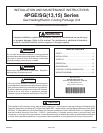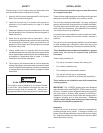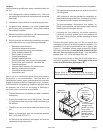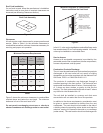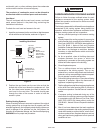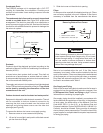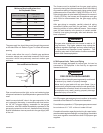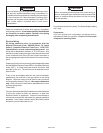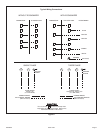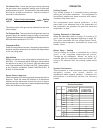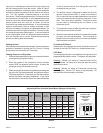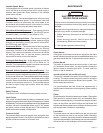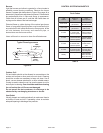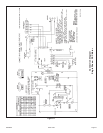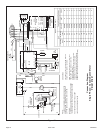
506488-01 Page 5Issue 1008
a sidewalk, patio, or other walkway where the condensate
could cause the surface to become slippery.
The products of combustion must not be allowed to
accumulate within a confined space and recirculate.
Vent Hood
The unit is shipped with the vent hood, screen, and sheet
metal screws packed in the plastic bag containing the
Installation Instructions.
To attach the vent hood and screen to the unit:
1. Insert the vent screen into the vent tube so that the screen
is flush with the end of the tube, as shown in Figure 4.
2. Position the vent hood over the vent tube so that the
slotted side of the hood faces the condenser coil. Use
the four sheet metal screws (provided) to secure the
vent hood to the vent tube. The screws should pass
through the sides of the screen in order to hold the
screen in place.
Existing Venting Systems
When an existing furnace is removed or replaced, the original
venting system may no longer be sized to properly vent the
attached appliances. An improperly sized venting system can
result in spillage of flue products into the living space, the
formation of condensate, leakage, etc. See the accompanying
WARNING box for proper test procedure.
Installing Vent Hood
Figure 4
Screen
Vent Hood
Top View
Slotted side of
vent hood faces
condenser coil.
Screen
Vent Tube
Front View
Screen is pre-formed
Vent Tube
NOTE:
Screws should
pass through
sides of screen
to hold screen
in place.
Failure to follow the steps outlined below for each
appliance connected to the venting system being
placed into operation could result in carbon monoxide
poisoning or death.
The following steps shall be followed for each appliance
connected to the venting system being placed into
operation, while all other appliances connected to the
common venting system are not in operation:
1. Seal any unused openings in the common venting
system.
2. Visually inspect the venting system for proper size
and horizontal pitch, as required in the National Fuel
Gas Code, ANSI Z223.1/NFPA 54 (latest edition) or
the CSA B149.1, Natural Gas and Propane
Installation Codes and these instructions. Determine
that there is no blockage or restriction, leakage,
corrosion, or other deficiencies which could cause
an unsafe condition.
3. As far as practical, close all building doors and
windows between the space in which the
appliance(s) connected to the venting system are
located and other spaces in the building.
4. Close fireplace dampers.
5. Turn on clothes dryers and any appliance not
connected to the venting system. Turn on any
exhaust fans, such as range hoods and bathroom
exhausts, so they are operating at maximum speed.
Do not operate a summer exhaust fan.
6. Follow the lighting instructions. Place the unit being
inspected in operation. Adjust the thermostat so
appliance is operating continuously.
7. Test for spillage from draft hood equipped appliances
at the draft hood relief opening after 5 minutes of
main burner operation. Use the flame of a match or
candle.
8. If improper venting is observed during any of the
above tests, the venting system must be corrected
in accordance with the National Fuel Gas Code,
ANSI Z223.1/NFPA 54 (latest edition) and/or the
CSA B149.1, Natural Gas and Propane Installation
Codes.
9. After it has been determined that each appliance
remaining connected to the venting system properly
vents when tested as outlined above, return doors,
windows, exhaust fans, fireplace dampers, and any
other gas-fired burning appliance to their previous
conditions of use.
CARBON MONOXIDE POISONING HAZARD
WARNING



